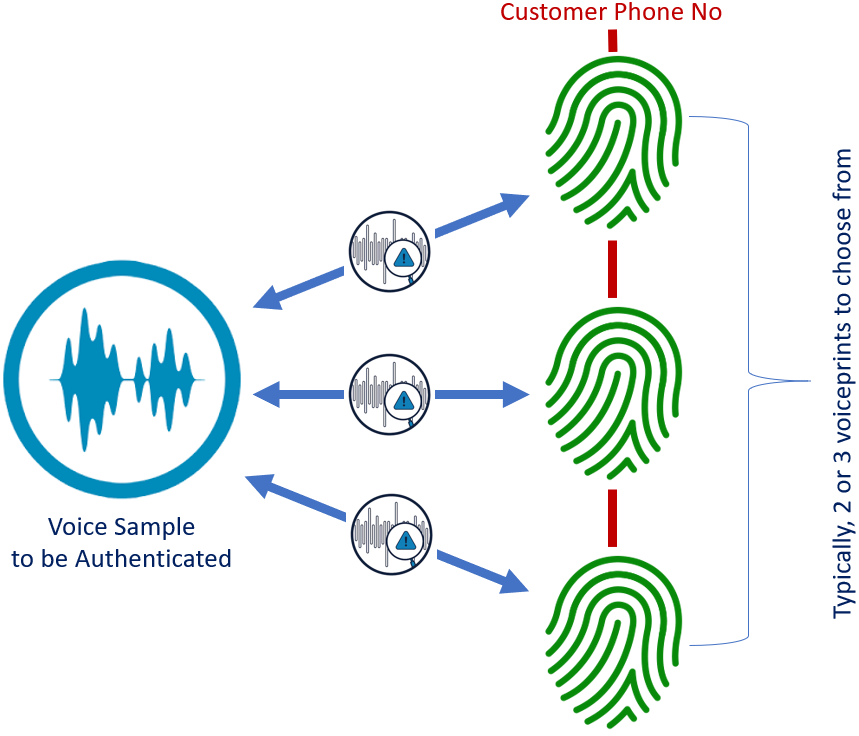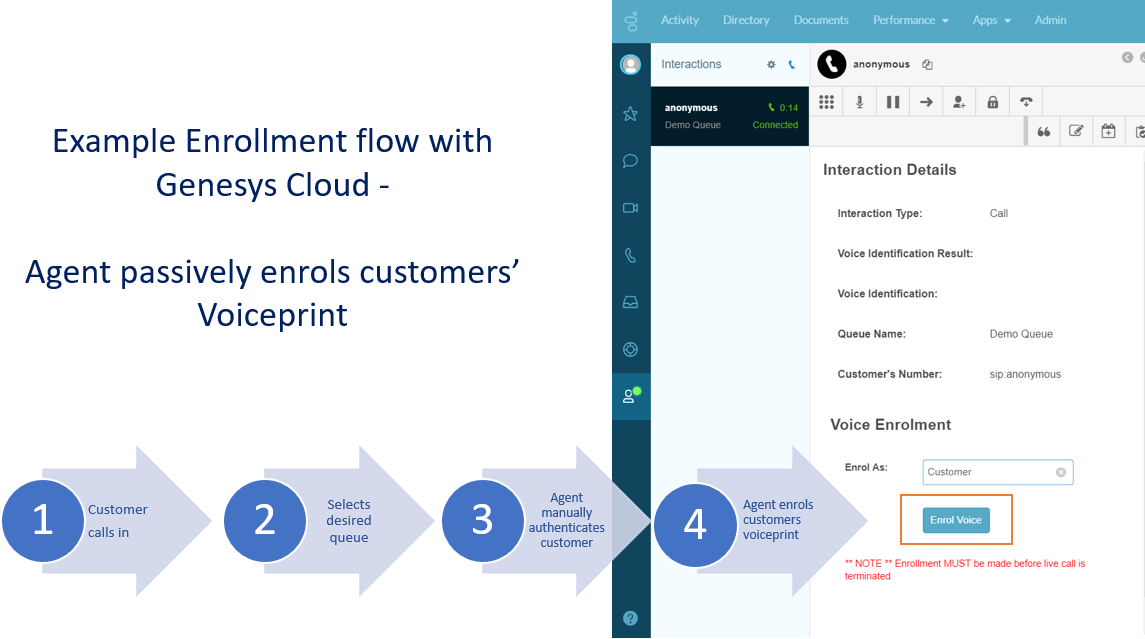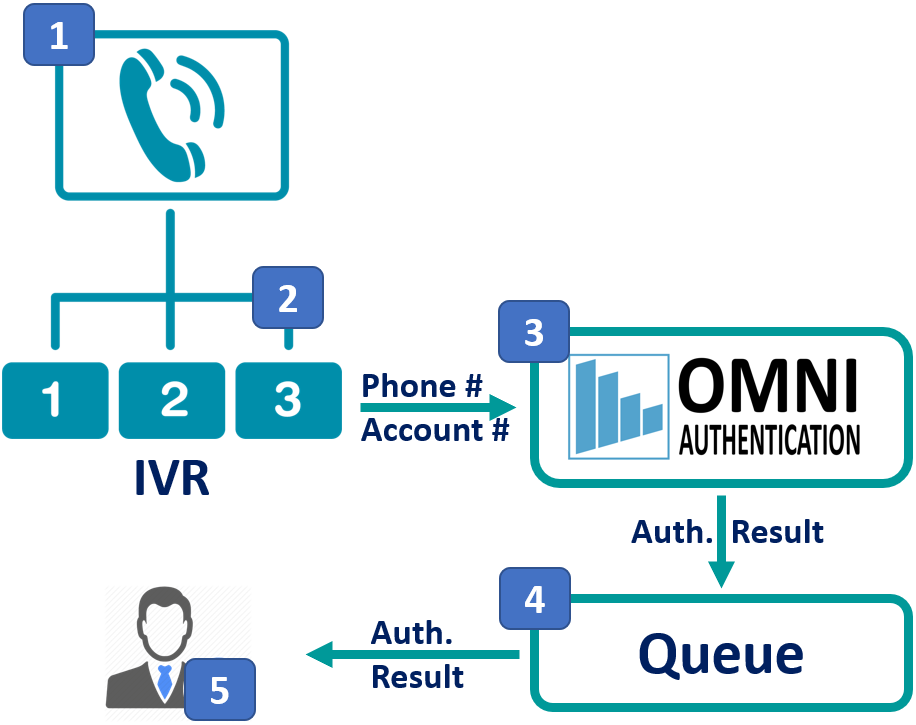Voice Biometrics Release (01 Jul 2020)
Introduction#
OI Voice Biometrics Quick Facts:
- Greatly improves CX
- Active Authentication and Passive Enrolment model is our default choice
- Omni Intelligence is Cloud CC-ready and has default integration with Genesys Cloud
- Low implementation and running costs - most affordable solution on the market for any business size
Voice Authentication solutions have been around for some time. They have rightfully earned the reputation of considerably improving Customer Experience in a Contact Center (CC) setting.
Simply put, a Voice Authentication solution allows to authenticate customers by their voice.
The authentication requirement arises whenever a customer's enquiry is related to some sort of private data. For example, it could be a credit card enquiry or insurance claim. Traditionally, the caller's identity was verified manually whereby a Contact Center representative would ask a number of questions that are:
- Easy to validate as their answers are on file
- Not readily available to an impostor
Leaving the security aspect for later, manual authentication poses a certain emotional burden on the caller who wish to address their issue as soon as they reach the agent after waiting in a queue. Furthermore, as the caller is transferred from one agent to another (which is a typical CC scenario), their security quiz validation is not retained and they face the same questions time and again.
Automatic Voice Authentication can resolve these issues:
- First, the number of questions asked is considerably less since all the Voice Biometrics system needs is just about 7 seconds sample of the caller's voice
- Second, it is generally an easy technical task to store the authentication result as part of the IVR flow. What it means is that if the caller is transferred to another IVR or agent, their authentication status would be preserved and visible to all agents
- Finally, the questions themselves can be fairly simple and the answers to these questions do not have to be precise or even delievered in a specific language
These benefits, however, are only attained if the authentication is done in a fully automated manner which is normally called Active Authentication.
In contrast to the active, Passive Authentication is done when the caller reaches the agent. The idea behind the Passive Authentication is to start a small talk with the caller and have the Voice Authentication system "listen" on the call at the background until the authentication result is obtained. Even though the Customer Experience benefit of this approach may seem better compared to the active case, there is no evidence whatsoever that Passive Authentication provides any better Customer Experience than the Active method. What is evident, though, is that the Passive Authentication requires more agent time thus adding to the Average Handling Time and, subsequently, making it more expensive for the Contact Center.
Take away: Voice Authentication provides considerable Customer Experience benefits
Take away: Passive Authentication is more expensive than Active and has questionable Customer Experience benefits
Security#
It has been widely publicised that Voice Authentication is a guarantee against fraud. This is most certainly false for a number of reasons. One of such reasons lies within the technology itself: recent developments in AI speech synthesis allow voice cloning. In other words, AI can now read any text with your voice with a great deal of fidelity. This is not the mainstream yet but the recent achievements in this area are quite impressive. Also, our voices are not as unique as our fingerprints. Based on our experimentation, the chance of "voice collision" is about 0.5% (1 in 200).
These facts make Voice Authentication not a "100% bulletproof" security solution. Neither it is suitable for customer account lookup by voice.
Is there any security benefit behind Voice Biometrics?
Even though the Voice Authentication technology's main benefit lies in the Customer Experience area, it still can improve the overall security somewhat, since faking voice, in general, is probably harder than finding out answers to those questions that are normally used for manual authentication. Besides, Speech Recognition technology might prove useful in "filtering out" a lot of attempts to fake someone's voice.
Take away: Voice Authentication provides only moderate security benefits
Principle of Operation#
Fundamentally, there are two main processes involved in the operation of a Voice Authentication solution:
- Enrolment: Voiceprint creation
- Authentication: Validation procedure that tells if a voice sample matches the given voiceprint
During the enrolment process, a customer voice sample is converted to a code that represents the characteristics of the customer voice. When the voiceprint is obtained as part of the enrolment, it is stored against some form of ID.
Voiceprints are stored against customer ID which is normally one of the following:
- Customer's Phone Number (CLI)
- Account Number
- CRM ID
As such, a single Customer ID can have multiple voiceprints associated with it. This number, however, is normally quite small which, in fact, makes the authentication so accurate and reliable.
- A voice sample is compared not to the whole database of voiceprints but to only a few, associated with the Customer ID
- When a voice sample is compared with a small number of voiceprints, the Voice Biometrics engine can tell which of the voiceprints it matches with
- This would be useful if, for example, multiple family members are associated with the same account. In this case, there will be multiple voiceprints stored under the same Customer ID:

Voice Authentication Flows#
Enrolment#
Customer Enrolment would normally follow a manual validation of the customer credentials. In other words, the customer would be asked the usual security questions when they reach the agent. If the agent is satisfied with the answers, they would normally click on the "Enrol" button that is embedded in the call pop:
- Customer calls in
- Selects desired queue
- Agent manually authenticates customer
- Agent enrols customer's voiceprint passively by clicking Enrol on the call pop

NOTE: It possible to pre-enrol the existing voice samples as long as there is a way of linking them with the Customer ID
Authentication#
While Enrolment would typically be done once or twice for the same person, Authentication is done each time the customer would call back with an enquiry. Let's take a look at a typical flow of Authentication process:
- Customer calls in
- Selects desired queue
- Call is transferred to the Voice Authentication server
- Call is transferred back to the queue
- Agent receives the call with the Authentication result

Cloud or Hosted#
Omni Intelligence Voice Biometrics is available as both, On-Premises as well as Hosted Service
Contact our Sales Team to find out how you can integrate Voice Biometrics into Your Contact Center.
Pricing Model#
Our Voice Biometrics solution is sold under both On-Demand and Subscription models:
- On-Demand:
- Billed based on the number of authentications
- Subscription:
- Multiple packages with various monthly allowances are available
- Contact our Sales for any specific requirements
Demo & Other Questions#
Our friendly and competent Sales Team will be happy to set up a Demo or to answer any further questions you might have